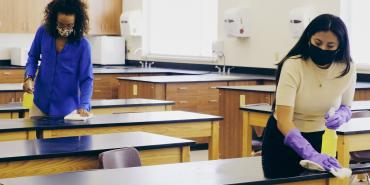On Aug. 25, AFT members tuned in to the union’s twice-monthly telephone town hall for a multifaceted discussion that not only addressed how to reopen schools safely, but also reimagined what learning might look like as this crisis breaks the old “factory model” of schooling wide open. Also spotlighted: How one state took on the need for pandemic-informed professional development and how one community school found innovative ways to be there for students and families.
Education scholar Linda Darling-Hammond previewed findings from a just-released Learning Policy Institute report, Restarting and Reinventing School: Learning in the Time of COVID and Beyond. The report identifies evidence-based policies and practices to redesign and transform our educational system—a system that, as Darling-Hammond pointed out, was created around 1920 for mass education on an assembly-line model and hasn’t changed much since.
“This is a moment of huge disruption and enormous social upheaval,” she said. “When we have these moments in American history, we find that it is often the moment at which enormous progressive social policy changes can be accomplished.”
The LPI report focuses on 10 policy priorities that “will help schools reinvent themselves around principles of equity, authentic learning, and stronger relationships,” from closing the digital divide to culturally responsive learning to more adequate and equitable school funding formulas.
Darling-Hammond emphasized that the United States has had a chronic teacher shortage for decades. “We’ve got to acknowledge the desperate need for trained educators. In allocating federal and state funds, we need to prioritize getting, keeping, recognizing, rewarding and supporting great teachers.” She noted that the community schools model had once again proven its resilience and value over the past six months: “This is a time to take advantage of community schools and spread them. Places that had wraparound support did much better in finding families and making sure kids and families stayed connected with the school.”
A shining example of how community schools have sustained students and families in the pandemic is Baltimore’s Wolfe Street Academy. Wolfe students are predominantly multilingual learners from low-income households. Many speak Mixtec, the language of an indigenous people in Mexico whose culture dates back to pre-Columbian times. Wolfe special education teacher Katrina Kickbush, a Baltimore Teachers Union building representative, spoke about the myriad ways the school reaches out to families, including helping them access food benefits and medical care, finding the best ways to communicate, bridging the digital divide, and supporting children’s learning at home.
Kickbush said, “We created a COVID relief team that created an application in Spanish and English that we would send out to our families through various social media, so families could get support for needs such as groceries. We have our social work interns helping as translators. Our after-school program could no longer continue, so we took the staff and put them with classroom teachers to support small breakout groups in [virtual] classrooms. We tapped into our parent network. For the languages we were not fluent in, like Mixtec, we had families who would translate content into voice memos so everyone in our community could understand what was going on. We did a partnership with AT&T to get tablets in students’ hands plus hot spots into the houses. We had about an 85 percent access rate.”
For AFT Massachusetts President Beth Kontos, recommitting to professional development is a key piece of helping educators walk into the new school year strong and purposeful, whether or not they’re actually walking into school buildings. (Boston schools will open with fully remote instruction. AFT Massachusetts continues to advocate for waiting to reopen school buildings until community spread is low.) The state federation negotiated with the state Department of Elementary and Secondary Education to reduce school calendar days from 190 to 180 in order to add 10 days of professional development to the year. Those days will be used, Kontos says, “to think about how we can change education. Most importantly, we need time to collaborate and rethink our curriculum. We’ll need to be flexible and engaging as we pivot out of our schools to teaching remotely.”
Student well-being is priority No. 1, says Kontos. “We’ve already started making phone calls and checking what students need. We’re checking on food insecurity. Some students have had to move and live with extended family because a parent lost a job. We ask if they feel safe in their environment, if they are able to get out for exercise. We have never needed community schools more than we do now. Many of our students will need all kinds of services. And no one can argue whether we need a nurse in every school now. We’ll need counselors. We will experience loss this year, we will have grief.”
AFT President Randi Weingarten fielded questions from callers, with the last caller drawing a powerful response describing how her district was giving each teacher one single mask for the first half of the school year.
“It’s ridiculous, it’s inhumane,” Weingarten said, “for someone to say we’ve given you one mask. The AFT will be on it tomorrow. This is part of the reason why we do these town halls. We don’t want people to feel like they’re unempowered. We are not going to let people be alone. This is a very scary moment. Know that we are here, and we are a tweet or an email or a phone call away.”
In response to another caller seeking help with distance learning techniques, Weingarten noted that the AFT’s popular Share My Lesson program includes extensive distance learning resources. The union also continues its battle for the crucial federal funding schools will need to recover and rebuild. A nationwide Save Our Schools Day of Action is planned for Sept. 2.
[Christina Bartolomeo]


